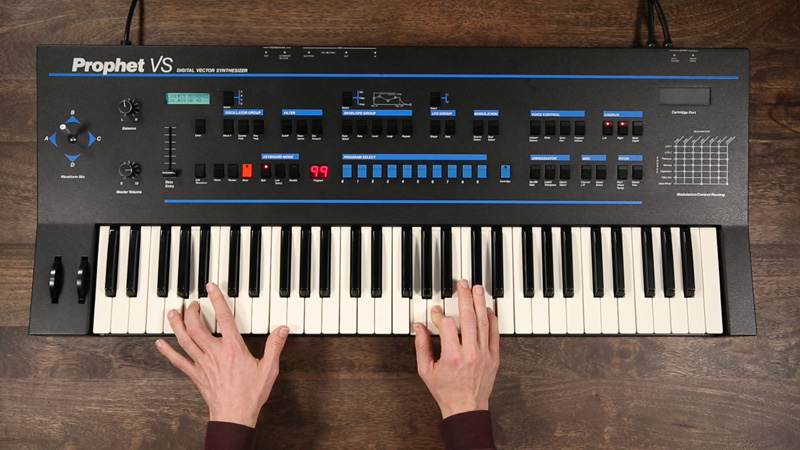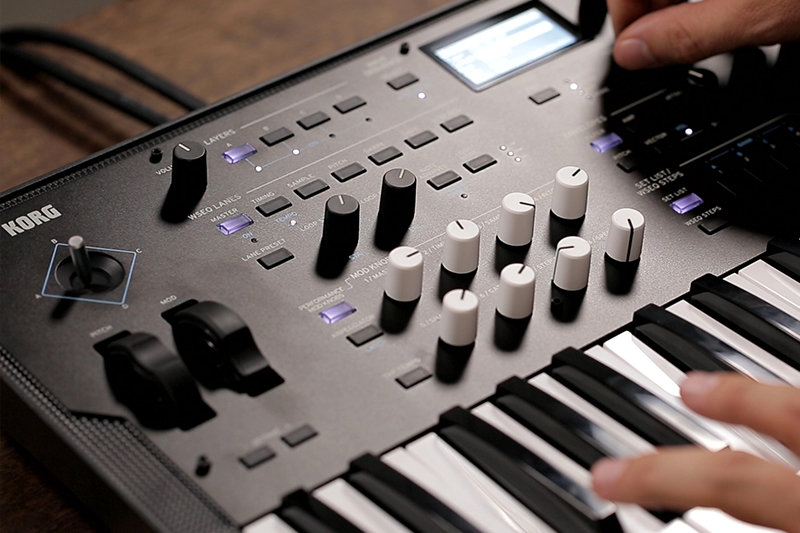Korg has introduced the Wavestate—the spiritual successor to their Wavestation series of instruments from the 1990s. Turning sound into a spatial metaphor, the Wavestation provided users a way to continuously morph between entirely distinct sound worlds at the flick of a joystick...and the Wavestate brings this concept into the present day, using similar methods to create sounds that feel every bit as futuristic and expansive as the Wavestation did two decades ago.
In its Minilogue-sized package, the Wavestate provides a more open-ended, hands-on approach to vector synthesis than any other synth to date.
Soundscape of the 1980s
The 1980s were a time of sonic exploration: synth designers were beginning to fully embrace digital technology as a solution to create sounds and control methods impossible with analog circuitry alone. New instruments often brought with them entirely new sonic vocabularies and novel means of control. And in many cases, these instruments were aimed toward creating continually-evolving timbres, breaking free of the limitations of pure subtractive analog synthesis in favor of finding new ways to warp sounds over time.

One of my favorite approaches from this period was that of the Sequential Circuits Prophet VS (to read more about the VS in particular, check out our article here). While prior Prophet-series synthesizers were primarily classic analog-style synthesizers, the VS took a boldly different approach. The Prophet VS sought to capture the rich timbral potential of instruments like the PPG Wave while maintaining its own unique sonic character...and it did so through its introduction of an entirely new synthesis method: Vector Synthesis.
Vector synthesis is conceptually similar to wavetable synthesis—but instead of relying on "tables" of gradually interpolated waves to create timbral morphing effects, it instead organizes several distinct timbres into an abstract two-dimensional space which users can traverse in order to find unique combinations of tones. In the Prophet VS, this manifests in the form of a diamond: a shape with four distinct timbres at each corner, which can be navigated with a dedicated joystick or through use of internal modulation sources. The effect is something like a two-dimensional crossfader that creates an astonishingly huge, immersive sound that can be as smooth or harsh as you desire. However, Sequential Circuits closed its doors in 1987.
The Korg Wavestation
Soon, though, additional companies picked up the vector synthesis concept and continued to refine it. Most notable of the expansions of vector synthesis is, of course, the method presented by Korg's Wavestation in 1990: Wave Sequencing. To understand wave sequencing, let's momentarily forget about the "vector" angle for a moment and focus on just one oscillator.
 The 2020 Wavestate's performance interface, complete with Vector joystick
The 2020 Wavestate's performance interface, complete with Vector joystick
Wave sequencing allows users to create a list of PCM waves to step through in a particular order. This is distinct from most prior wavetable approaches in that synths like the PPG Wave had a predetermined wave order for each table, and only relatively traditional/linear ways of traversing the table (key pressure, aftertouch, etc). The Wavestation, though, allowed you to determine exactly which waves you wanted to hear and when you wanted to hear them...an unprecedented level of control for this type of synthesizer. Moreover, every step of a wave sequence could have its own pitch, fine tuning, loudness, and crossfade smoothness—so any effect from smooth to jarring was accessible.
The Wavestation allows this type of wave sequence for each of its four oscillators at the same time—so when combined with the 2D vector-style crossfading described above, this could create outrageously huge, rich soundscapes and pseudo-sequences from even a single note. As such, the Wavestation became famous for its intricately detailed, atmospheric sounds, and was often used for patiently-unfolding cinematic textures. The Wavestation was produced in several different hardware models, and was eventually resurrected in 2004 as part of Korg's Legacy Collection series of virtual instruments. Most recently, Korg released the iWavestation app for iOS, providing the same workflow as the original device for use on iPhones and iPads.
Introducing the Korg Wavestate
And now, with the first major synth announcement of the 2020s, Korg presents the newest member of the Wavestation lineage: the Wavestate. Wavestate is a Minilogue-sized keyboard synthesizer that brings Wave Sequencing concepts into the 21st century. Wavestate provides 6GB of PCM sounds, meaning that over 700 sounds are at your fingertips...with infinite options for how to arrange them relative to one another. It includes 1000 wave sequences to explore, and offers storage for over 10,000 performances—so you won't find its limits anytime soon (or, perhaps, ever).
One of Wavestate's most powerful features is its expanded potential for user control, providing altogether new ways of traversing timbral space for completely smooth or even unpredictable results. Users can create far-reaching sonic changes with the eight white macro knobs, can randomize settings at the push of a button, or can dive deep into the synth's expansive modulation options. The wave sequencing section itself includes extensive options for manipulating pitch, timing, sample selection, and more, as well as control of sequence direction, loop start and end points, and much more. And of course, the envelope section provides extended control of the vector aspect of the Wavestate's design—providing a strikingly Prophet VS-like envelope with multiple breakpoints, capable of looping, reversing direction, and more.
As of the time of writing this article, not all of the Wavestate's features are clear: we know that it has 64-note polyphony, up to 14 simultaneous effects (include modulation effects, delays, reverbs, and more), and can discern from its panel that there are variable-shape LFOs for multiple parameters, velocity-capable envelopes, multiple simultaneous layers, an integrated arpeggiator and sequencer, and more. What we know for sure is that the Wavestate sounds remarkable—producing impossibly rich tones that seem to drift between worlds, evoking a sense of montage that shifts between open, airy spaces to grinding industrial centers, deep ocean to outer space, orchestra halls to unreal mechanical spaces.
If you want impossibly lush pads, chattering rhythmic timbre sequences, intensely intricate percussion patterns, or just distinct leads and bass lines with a load of hands-on control, the Wavestate just might be the synth for you. It's already clear that this synth has an uncommon level of depth and programmability, so we expect it to every bit as exciting to newcomers who want to explore presets as it will be to experienced users who want to dive in to a rich, idiosyncratic synthesis environment.












